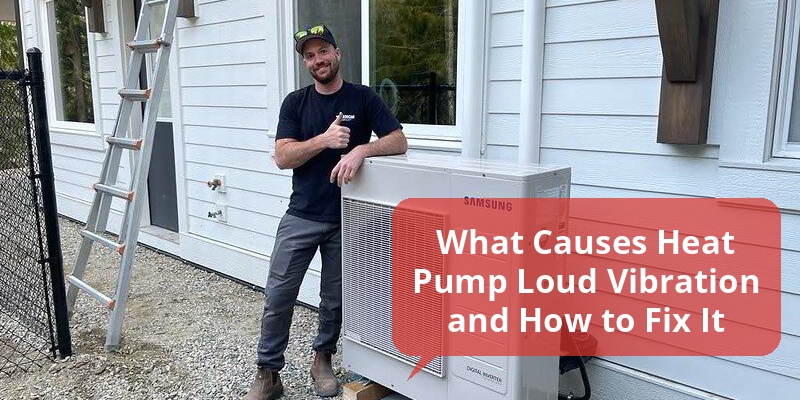Heat pumps are an efficient way to regulate home temperature, but loud vibrations can disrupt comfort and signal underlying issues. Understanding the common causes of heat pump loud vibration helps homeowners address the problem promptly, preventing costly repairs and improving system performance. This article explores the primary reasons for vibration noise, diagnostic tips, and practical solutions to silence your heat pump.
| Common Cause | Symptoms | Suggested Fixes |
|---|---|---|
| Loose or Damaged Components | Rattling or thumping vibrations when running | Tighten screws, replace worn parts, secure panels |
| Unbalanced Fan or Motor | Loud humming with consistent vibration | Balance or replace fan blades, check motor mounts |
| Foundation or Mounting Issues | Whole unit shaking or amplified vibration | Stabilize or level foundation, use vibration isolators |
| Debris or Ice Buildup | Intermittent noise, grinding or clicking sounds | Clean unit, remove debris, defrost if icy |
| Refrigerant Issues or Compressor Problems | Unusual pulsating noise, system underperformance | Call professional for inspection and repair |
Common Causes of Loud Vibration in Heat Pumps
Heat pump vibration noise is frequently caused by mechanical or structural factors. Loose components such as screws, panels, or bolts can create rattling sounds when the system operates. Similarly, worn or damaged parts like fan blades or motor mounts often result in persistent vibration.
Additionally, an unbalanced fan or motor rotor can cause continuous humming and shaking. During operation, ice or debris buildup around the outdoor unit disrupts the smooth rotation of fan blades, leading to intermittent grinding or clicking noises.
The heat pump’s foundation also plays a critical role. If the unit is placed on uneven ground or suffers from deteriorated mounts, the entire system may shake or resonate loudly. In some cases, issues related to refrigerant circulation or compressor malfunctions produce abnormal vibration accompanied by performance decline.
How to Diagnose the Source of Heat Pump Vibration Noise
Diagnosing vibration issues requires a systematic approach. First, visually inspect the outdoor unit for loose panels, screws, or detached components. Running the heat pump can help identify which parts vibrate excessively or cause noise.
Check the fan blades for signs of damage, dirt, or imbalance. Spinning the fan manually when the unit is off can reveal resistance or uneven movement. Assess motor mounts and mounting brackets to ensure the motor is firmly secured without excessive play.
Observe the unit’s placement and foundation. A heat pump on soft soil, sloped ground, or an unstable platform tends to vibrate more. Gently rocking the unit can expose instability or weak mounts. Also, listen for vibration patterns, noting whether noise is constant or linked to specific operating stages.
Steps to Fix Loud Vibration in Heat Pumps
Tighten and Secure Loose Parts
Loose screws, bolts, and panels are among the easiest fixes. Use a screwdriver or wrench to tighten all exposed fasteners. Replace any missing or stripped screws to prevent further movement. Secure loose panels with additional clips if necessary to reduce rattling sounds.
Balance or Replace Fan Blades
Unbalanced fan blades create uneven vibration. Manually inspecting each blade for damage or dirt buildup is essential. Clean accumulated debris thoroughly, and straighten bent blades. If imbalance persists, professional rebalancing or fan replacement may be necessary.
Inspect and Stabilize the Unit’s Foundation
Ensure the heat pump stands on a flat, solid surface. If the base is uneven, level it using shims or a concrete pad. Vibration isolators or rubber mounts underneath can absorb shaking and prevent resonance. Avoid placing the unit directly on soft soil or unstable platforms.
Remove Debris and Prevent Ice Build-Up
Clear leaves, dirt, and other debris away from the outdoor unit regularly. During winter, check for frost or ice coating on coils and fans. Use the defrost mode as recommended or call a technician to address excessive ice buildup.
Consult a Professional for Compressor or Refrigerant Issues
Noise related to the compressor or refrigerant often requires technical expertise. Symptoms include pulsating vibrations or noticeable drops in heating and cooling efficiency. Scheduling professional HVAC inspection and repair is essential to avoid major failures.
Preventive Tips to Avoid Heat Pump Vibration Problems
- Regular Maintenance: Schedule seasonal inspections to tighten components, clean fans, and check refrigerant levels.
- Proper Installation: Ensure the unit is installed on a level, sturdy platform with vibration pads when possible.
- Debris Management: Keep the area around the outdoor unit clear from plants, leaves, and construction materials.
- Monitor Performance: Listen for unusual noises and vibrations promptly to catch problems early.
- Professional Servicing: Employ licensed HVAC technicians for routine servicing and complex repairs.
Impact of Loud Vibration on Heat Pump Efficiency and Longevity
Loud vibration not only disrupts home comfort but can contribute to accelerated wear and tear on mechanical parts. Persistent shaking stresses the fan motor, compressor, and mounting hardware, leading to premature failures.
Vibration-induced damage often translates into higher energy bills and costly repairs. Addressing loud vibrations swiftly protects investment and maintains optimal heat pump efficiency. Sound and stable operation extends equipment lifespan and ensures consistent climate control performance.
When to Call a HVAC Professional
Minor noise and vibrations can often be fixed with simple homeowner maintenance. However, professional evaluation is necessary if:
- The noise is loud, continuous, or worsens over time.
- There are signs of refrigerant leaks or compressor problems.
- DIY tightening and cleaning do not reduce vibration.
- The unit shakes the entire platform or causes structural vibrations.
Professional technicians use specialized tools to diagnose hidden problems and safely repair electrical, refrigerant, or compressor components to restore quiet operation.
